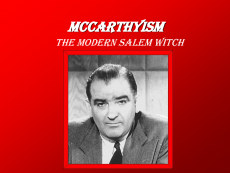
In creating the allegory Miller provides a note on historical accuracy as he references ‘A Modest Inquiry into the Nature of Witchcraft’ by John Hale, 1967. His devotion to maintaining what historical accuracy is possible within the play just further supports the notion that Miller wrote an allegory designed to warn future generations of the dangers of foolish paranoia leading to rash actions. In the Salem Witch Trials 19 people were hung and one man of over 80 years pressed to death under heavy stones whilst in the period of McCarthyism thousands of Americans lost their jobs and hundreds were falsely persecuted and served jail sentences. However, one could apply the situation/warning Miller conceives to any given situation where public opinion takes control and creates panic or affects the outcome of justice. Author of ‘The Devil in Massachusetts’ Marion. L. Starkey reflected it seems that the socialist Miller is sometimes “an enemy of the people” but in his condemning of the public he endeavours to preserve the future. Therefore, ‘The Crucible’ is not necessarily totally an allegory of McCarthyism in early 1950s America but a universal warning to learn from the mistakes made in the past.
Having said this, Miller was denied employment in the private sector and failed the American Government security checks so it is very probable that in writing ‘The Crucible’ he expressed his own ideology as a method of ‘attacking’ the corruption of the McCarthy era in which he was made a victim thus the play is most definitely an allegory of the time. The false acceptance and accusations associated with McCarthyism are dramatised at the end of Act 1 when Abigail seizes her opportunity to ‘be accepted’ by the town of Salem, “I want to open myself! . . . I want the light of God, I want the sweet love of Jesus! I danced for the Devil; I saw him, I wrote in his book; I go back to Jesus; I kiss His hand. I saw Sarah Good with the Devil! I saw Goody Osburn with the Devil! I saw Bridget Bishop with the Devil!”
Furthermore if we take the protagonist John Proctor as representing Miller himself and his struggle then we see how the themes and motifs of the play create “not so much a story of two ideologies in conflict as a story of conscientious endeavour in an uncertain world.” For example in Act II when Elizabeth (Proctor’s wife) relates to him what she has heard, “Elizabeth: The Deputy Governor promise hanging’ if they’ll not confess, John. The town’s gone wild, I think. She speak of Abigail, and I thought she were a saint, to hear her.” “Proctor: Oh, it is a black mischief.” Elizabeth: I think you must go to Salem, John, I think so. You must tell them it is a fraud.” Elizabeth’s suggestions are the thoughts of a worried but honest mind; “I think” is implication not an order. This reflects the aforementioned words of Yeats. “The best”, in the allegory Elizabeth and John Proctor, seek to honestly expose this fraud and paranoia but are hesitant suggesting with “ I think” – a deliberate word choice by Miller whilst characters such as Parris (“the worst”) rant on and once again Miller chooses the language carefully “you are.. you must... one shan’t ever”. ‘The Crucible’ is not only an allegory of McCarthyism but a warning of the dangers it entails and a direct attack on the Senator himself and his ideologies.
The word ‘Crucible’ itself means a metal container in which metals or other substances are subjected to high temperatures. Each character is metaphorically a metal subjected to the heat of the surrounding situation, thus the title itself is an allegory of the definition of McCarthyism; the extreme heat or pressure and paranoia of the ‘Red Scare’ in early 1950s America. Furthermore some of these metals, speaking metaphorically, withstand the intense heat and do not melt in the face of false persecution and death such as John Proctor, Miller’s protagonist; for the message of attacking McCarthyism. A Crucible can also mean a severe test, something the characters in the play each face; a test not to conform and act irrationally under false pretences in face of fear and paranoia. This is the essence of McCarthyism, Miller’s purpose in writing ‘The Crucible’ was to combat the mindset of ‘The Red Scare’ and challenge authority, to open the eyes of the people and challenge mindless obedience to that which is not true or without empirical evidence in a time of panic. Thus Arthur Miller’s ‘The Crucible’ is largely if not entirely an allegory of McCarthyism in early 1950s America.

0 Comment:
Be the first one to comment on this article.